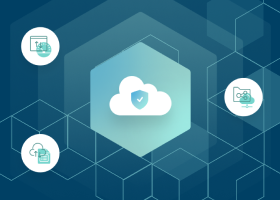On Premises vs Cloud: Differences, Benefits, and Risks
When it comes to building your IT foundation, the on-premises vs cloud debate is a definitive one. What is on-premises infrastructure? It means hosting your data and systems locally, giving you full control but demanding high upfront investment, ongoing maintenance, and dedicated IT resources. Cloud solutions flip the model.
With options like software as a service vs on premise, you trade hardware headaches for instant scalability and streamlined operations, though you hand over some control. The real challenge isn’t just technology; it’s aligning your infrastructure with your business mindset.
Do you prioritize ownership, even if it slows agility? Or do you value flexibility, even if it means relying on external platforms? This decision shapes IT costs, data security, and how fast your business grows in a competitive market.
Let’s jump in and learn:
- What is On-Premise Software?
- On-Premise Software: Advantages vs Disadvantages
- What is Cloud Computing?
- Understand On-Premise vs. Cloud to Find the Right Solution
- How Egnyte Helps Firms Streamline Access and Eliminate On-Premise Overhead
- Case Study:
- Future of On-Premise vs. Cloud in 2025 and Beyond
- Conclusion
What is On-Premise Software?
On-premises software refers to applications hosted on your own servers, managed internally by your IT team. Unlike cloud solutions that run off-site, all data, applications, and security remain within your physical infrastructure. This model is best suited for organizations with strict compliance needs or highly sensitive data that requires a centralized document management system.
Understanding the difference between on-premises and cloud helps you assess which model best aligns with your control, cost, and scalability goals.
On-Premise Software: Advantages vs Disadvantages
Advantages:
- Full ownership of infrastructure and data, ideal for industries with strict data sovereignty requirements.
- Security architecture can be tailored to meet internal standards and regulations (like HIPAA, SOX).
- Unaffected by internet outages or bandwidth issues, suitable for performance-critical environments.
- In-house teams control all audits, access logs, and policy enforcement.
- Reduced exposure to multi-tenant vulnerabilities or shared infrastructure threats.
Disadvantages:
- Significant upfront costs for hardware, licenses, and deployment.
- Ongoing responsibility for updates, monitoring, and incident response rests with internal teams.
- Scaling requires new physical infrastructure, delaying time-to-capacity.
- Requires additional tools or VPNs for secure external access.
- Changes often require manual intervention, delaying the innovation rollout.
What is Cloud Computing?
Cloud computing delivers software, storage, and infrastructure over the internet, eliminating the need for on-site hardware. Instead of owning servers, you access resources on demand through a provider. This shift is central to the difference between on-premises and cloud solutions, where cloud solutions emphasize flexibility, speed, and scalability.
In the on-premises vs cloud comparison, cloud stands out for teams that value agility without the overhead of infrastructure management
Advantages of Cloud Computing:
Here’s where cloud excels in the cloud vs. on-premises pros and cons discussion:
- Minimal Upfront Costs : No hardware to buy, just pay as you go. A key benefit in any cloud vs. on-premises cost comparison.
- Scalable on Demand: Add or reduce resources instantly, based on business needs.
- Remote-Ready by Design: Access systems and collaborate from anywhere—no VPNs needed.
- Provider-Managed Maintenance: Updates and support are handled externally, freeing your IT team.
These advantages often tip the scale in favor of cloud in the on-premises vs cloud comparison.
Disadvantages of Cloud Computing:
Cloud computing flexibility comes with considerations:
- Shared Control: You rely on the provider for security and uptime, an issue for compliance-heavy sectors.
- Ongoing Subscription Costs: Monthly or usage-based pricing can add up over time if your bills are not cleared on time.
- Internet Reliance: A stable connection is a must; downtime can disrupt operations.
Understanding these trade-offs is crucial when evaluating the cloud vs. on-premises pros and cons in your environment.
Understand On-Premise vs. Cloud to Find the Right Solution
There’s no one-size-fits-all answer when it comes to choosing between on premise vs cloud. Each model brings unique strengths and limitations, depending on your business’s size, compliance needs, IT resources, and growth trajectory.
If you operate in a highly regulated industry like healthcare, finance, education, e-commerce, or government agencies, on-premise may offer the control and data residency you require. But that control comes with higher costs and heavier internal responsibilities.
On the other hand, cloud solutions provide flexibility, scalability, and speed, especially valuable for hybrid teams, growing businesses, or organizations that want to offload infrastructure management. Many find that, in the cloud vs on premise pros and cons equation, cloud offers better alignment with modern work demands.
The real insight? It’s not just about choosing one over the other; it’s about aligning your infrastructure strategy with business priorities.
For a deeper breakdown of functional trade-offs, explore Cloud Applications vs. On-Premises File Servers to see how modern solutions compare in real-world scenarios.
How Egnyte Helps Firms Streamline Access and Eliminate On-Premise Overhead
For construction teams managing remote job sites, tight timelines, and compliance requirements, legacy file servers quickly become a bottleneck. Egnyte offers a smarter approach, a secure, cloud-based content platform that simplifies document access, reduces infrastructure costs, and scales with your projects.
With hybrid-ready deployment and deep integration into industry tools like Autodesk, Egnyte makes it easy for regulated organizations to modernize without sacrificing control.
Case Study:
C.W. Driver Cos. Eliminates On-Prem Servers and Boosts Field Efficiency
C.W. Driver Cos., a major construction management firm, was spending heavily on maintaining on-premise storage, hardware upgrades, software licenses, and meeting growing IT demands, which were slowing operations. Field teams struggled to access up-to-date project documents on-site, leading to delays and duplicated work.
The Solution
By migrating to Egnyte’s cloud platform, the company:
- Retired 20 on-premise file servers, slashing infrastructure costs
- Enabled secure, mobile access to drawings and RFIs for field teams
- Integrated with Autodesk tools to keep project workflows connected
- Delivered a seamless, mapped-drive user experience, now in the cloud
The result? A centralized, low-maintenance system that boosted collaboration, lightened IT load, and gained executive confidence. Egnyte now powers operations as a secure, scalable Cloud File Server, built for compliance and collaboration across field teams.
Future of On-Premise vs. Cloud in 2025 and Beyond
Looking ahead, a hybrid infrastructure strategy increasingly dominates. By the end of 2025, 75% of enterprise-generated data is expected to be processed outside traditional cloud data centers. This number was at 10% just seven years ago, reflecting the growing role of decentralized computing.
- AI integration is reshaping deployment models: while the cloud remains essential for large-scale model training and analytics, edge AI is essential for real-time, privacy-sensitive workloads.
- Edge computing offers reduced latency, bandwidth savings, and enhanced control, making it indispensable for regulated industries or mission-critical applications.
- Meanwhile, cloud optimization is emerging as a strategic priority: enterprises are investing in AI-optimized cloud hardware (CPUs, DPUs, and confidential computing) to boost performance, security, and cost-efficiency for demanding workloads.
In this evolving landscape, successful organizations will adopt flexible hybrid models, blending on-premise, cloud, and edge deployments to maximize compliance, performance, and resilience.
Conclusion
Whether you lean toward cloud, stay fully on-premise, or need a hybrid setup, Egnyte helps you get there without compromise.
Egnyte’s unified platform supports both deployment models, giving you the flexibility to meet data governance, security, and collaboration needs on your terms. You can start with cloud-first collaboration, keep sensitive content on-premise, and centrally manage policies across both.
That’s the difference with Egnyte, you’re not forced to choose sides in the on premise vs cloud comparison, you get the best of both. And with intelligent features like AI-powered automated data governance and compliance controls, you stay ready for whatever comes next.
Additional Resources

Cloud Application for File Sharing
Understand how cloud-based applications enable secure, scalable file sharing and collaboration across teams.

NAS for File Sharing
Explore how Network Attached Storage supports secure, centralized file sharing and when to choose NAS over ...

Public Cloud in Governance
Understand how public cloud environments impact data governance, security, and compliance strategies.